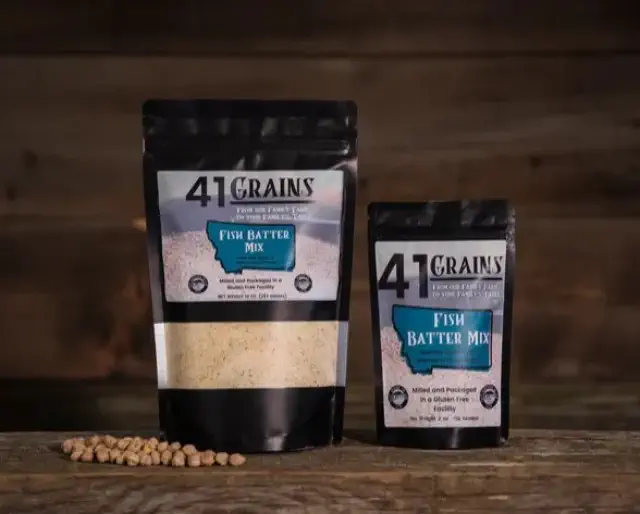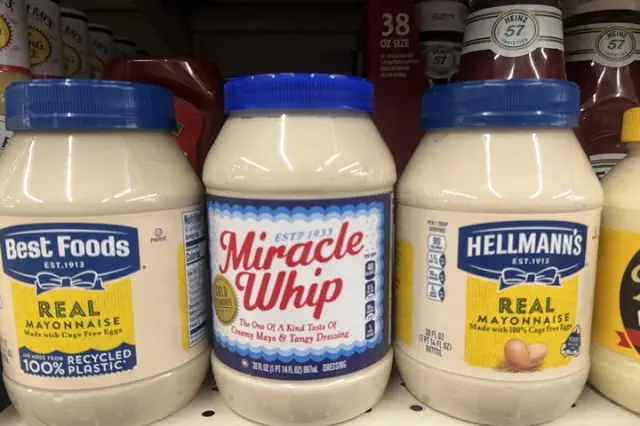
Gluten-Free Fish Batter: Perfect Pairings with Sauces and Sides for a Wholesome Meal
View pictures in App save up to 80% data. When it comes to creating the perfect meal with gluten-free fish batter, the key is to find the right balance of flavors and textures that complement the crispy, light batter, and tender fish. Whether you’re preparing a simple family dinner or hosting a gathering, pairing your gluten-free battered fish with delicious sides and dipping sauces can elevate the dish and create a satisfying, well-rounded meal. In this guide, we’ll explore the best sauces, sides, and complementary additions to make your gluten-free fish batter shine. Top Sauces for Gluten-Free Fish Battering The sauce you select can truly elevate or ruin your fish dish. Here are several traditional and inventive sauce choices to complement your gluten-free fish batter: 1. Tartare Sauce A timeless duo, tartar sauce offers a rich and zesty counterpoint to crispy fish. The mix of mayonnaise, pickles, capers, and a splash of lemon enhances the taste of the fried fish beautifully. For an added twist, consider incorporating some finely minced fresh herbs such as dill or parsley to elevate the sauce's freshness. 2. Citrus Garlic Aioli If you're looking for a brighter, citrus-infused option, lemon aioli is a fantastic selection. Its creamy consistency and zesty lemon taste complement the fish beautifully without being too strong. Additionally, aioli provides a refined alternative to classic tartar sauce, making it an ideal addition to an elegant dining experience. 3. Spicy Sweet Chili Sauce If you're in the mood for something with a kick, sweet chili sauce is an excellent choice. Its harmonious blend of sweetness and spiciness introduces a striking contrast to the delicate taste of the fish, resulting in a more exciting flavor experience. 4. Gluten-Free Sauce If you’re looking for a savory enhancement, gluten-free gravy mix can be a wonderful choice. A hearty, warm gravy created from gluten-free mix brings a rich flavor and comforting touch to your meal. Drizzle it over the fish or present it as a dipping sauce on the side — in any case, it’s a delicious complement. Tasty Accompaniments to Enhance Your Fish Dishes The right accompaniments can enhance your meal and balance the light, crispy texture of the gluten-free fish batter. Consider these side dish suggestions to pair with your fish: 1. Traditional French Fries No seafood meal is truly finished without a side of crispy, golden fries. They complement battered fish beautifully, providing a delightful crunch that balances the fish's soft texture. For an added flair, dust the fries with a sprinkle of sea salt and present them alongside your favorite dipping sauces. 2. Cabbage Salad A zesty, creamy coleslaw makes for an excellent side dish that complements battered fish perfectly. The crispness of the cabbage combined with the smooth dressing brings both texture and harmony to the plate. Feel free to stick with a classic coleslaw or experiment with variations that incorporate shredded carrots, apples, or a hint of mustard for added flavor. 3. Crisp Garden Salad To complement the richness of the fish batter, a fresh salad offers a delightful and healthy alternative. A basic green salad featuring a mix of leafy greens, cherry tomatoes, cucumber, and a light vinaigrette can be a perfect choice. Alternatively, you might opt for a heartier salad incorporating ingredients such as avocado, roasted beets, or crumbled feta cheese. 4. Oven-Roasted Veggies Oven-roasted vegetables like carrots, zucchini, and Brussels sprouts add a delicious savory touch to your dish. Their inherent sweetness and caramelized taste complement the fish beautifully. Enhance their flavor by drizzling with olive oil, adding garlic, and sprinkling some herbs. Extra Accompaniments for a Well-Rounded Meal If you want to enhance the diversity of your meal, think about incorporating some extra side dishes such as: Gluten-Free Baked Beans: Sweet and savory baked beans provide a comforting, hearty side that pairs well with fish. Rice Pilaf: A light, fluffy rice pilaf with herbs can be a great way to balance the meal, offering a neutral base to complement the fish. Corn on the Cob: Grilled or boiled corn on the cob, with a touch of butter and seasoning, adds a sweet and satisfying side to your plate. Elevate Your Dining Experience with 41 Types of Grains Enhance the flavor of your meals by incorporating 41 Grains gluten-free products into your side dishes. For instance, 41 Grains provides a variety of gluten-free choices, such as baking mixes and flours, which can be transformed into tasty sides like zesty muffins or gluten-free bread to accompany your fish. Additionally, their gluten-free gravy mix is an excellent choice to elevate your meal, delivering a delicious and hearty gravy that pairs wonderfully with the crunchy fish coating. Final Thoughts Creating a complete meal with gluten-free fish batter involves more than just the fish itself — it’s about pairing it with the right sauces and sides that enhance the overall dining experience. From tangy tartar sauce to savory gravy and crispy fries, there are countless ways to complement the delicate flavors of the fish. For a truly well-rounded meal, add fresh salads, roasted vegetables, or coleslaw to your plate, and don’t forget to explore the range of gluten-free options from 41 Grains to elevate your meal. With these tips, you’ll be able to pack your plate with flavors that perfectly complement the light, crispy texture of your gluten-free battered fish.

Let’s Discuss...Mayonnaise
View pictures in App save up to 80% data. The mayonnaise trio, but only two of them are actually mayonnaise. Sure! One of my goals for the New Year is to "take things less seriously." I can hardly imagine a more enjoyable topic than chatting about that often misunderstood condiment, which tends to be one of the first items discarded when people embark on their post-holiday dieting journey. Indeed, I'm referring to mayonnaise. You either adore it or despise it. Allow me to share some context. I have a deep appreciation for condiments in all their varieties. Mustard is a particular favorite of mine, whether it's Dijon, brown, spicy, yellow, or even infused with horseradish. I'm also a fan of aioli, various salad dressings, olive oil, ketchup, and just about any other condiment you can think of. I have a reputation for enjoying a sandwich that's solely comprised of condiments. To me, the true essence of a sandwich lies in the toppings. The meat, cheese, lettuce, and tomato serve merely as vessels to carry the delightful flavors of the condiments. I have a friend who won’t put any condiments on his sandwiches at all. To me, that feels like taking the frosting off a cupcake. Mayonnaise reigns supreme among condiments. You might have a different opinion, but I have solid arguments to back up my claim. Allow me to clarify. I discovered mayonnaise quite late in my life. My mom often mentioned that we were using mayonnaise in our tuna salad, but I later realized that she was actually using Miracle Whip instead. I discovered that Miracle Whip is not the same as mayonnaise. The label on the Miracle Whip jar explicitly says it is "dressing." While I'm uncertain about the exact definition of "dressing," it is clear that it isn't simply mayonnaise. My mother would mix Miracle Whip into tuna, potato salad, egg salad, and macaroni salad, confidently referring to it as "mayonnaise." (Although we pronounced it "mannays" and never used the term "mayo"). I had faith in her. When I was around 8 years old, I went over to my friend Colette Ogle's house for lunch. Her mom prepared tuna sandwiches for us. The moment I took a bite, I felt like my entire world had changed. What was this incredible flavor? It was by far the tastiest tuna sandwich I had ever tasted, and I made sure to let Mrs. Ogle know just how much I loved it. I returned home and shared my experience with my mom. I told her, "Mom, you need to find out from Mrs. Ogle what ingredients she uses in her tuna. It was absolutely amazing!" My mom inquired with Mrs. Ogle, who explained that it was merely tuna mixed with mayonnaise. How could that possibly be? If that were the case, it should have tasted exactly like my mom's tuna (disregarding the differences in tuna brands and whether it was packed in oil or water). The next time I visited Colette's home, I requested Mrs. Ogle to show me the jar of mayonnaise. What was this? It appeared completely different. I had been misled my entire existence! As I returned home, the realization hit me that my mother had concealed the truth from me all those years. I felt a deep sense of embarrassment. What was going through her mind? Miracle Whip is sweet, lower in calories, and was cheaper back in the day. But none of these points registered with an eight-year-old girl. I felt tricked. And I turned into a passionate supporter. Time passed, and mayonnaise turned into a regular item in my home. As a broke college student, my kitchen was usually stocked with just condiments and perhaps a hot dog bun. I distinctly recall having mayo and mustard on a bun for dinner on multiple occasions. Before long, I discovered a community of fellow mayonnaise enthusiasts. One memorable encounter was with a girl who customized her Burger King Whoppers by requesting extra mayo, only to top it off with a minimum of six additional packets. Some might say she crossed the line, but who am I to criticize? Then there is the ongoing debate about which mayonnaise is best – Best Foods or Hellman's? Some people add Duke's to that equation. I do not. Duke's is cousin to the other two. But that is another issue. Conversely, my husband had never experienced mayonnaise before we crossed paths. Growing up in a Jewish family, mayonnaise was seen as a culturally significant food. No reputable Jewish deli would dare to serve mayonnaise as a topping. Mustard was the go-to choice, but mayo was simply off the table. I found it quite confusing. Wasn't there mayonnaise in their egg salad and tuna salad? It seemed to be an unspoken topic among everyone. My husband may not be a huge fan, but he definitely prefers it over Miracle Whip, so it all balances out. Nowadays, many individuals believe that sour cream or Greek yogurt can be used as alternatives to mayonnaise. However, this is not the case. You may start to acclimate to them and convince yourself they have a similar flavor, but believe me, the moment you experience authentic mayonnaise again, there’s no turning back. It’s comparable to choosing frozen yogurt over ice cream. You can insist that frozen yogurt is just as good, or even superior to ice cream, as much as you like. However, once you indulge in ice cream again, it becomes obvious that it’s an entirely different experience. Go ahead and slather on that mayo, and be sure to reject any fakes!

7 Common Misconceptions About Plant-Based Meat: What Ingredients Are in Your Veggie Burger?
View pictures in App save up to 80% data. Curious about what's actually in your veggie burger? These seven common misconceptions about plant-based meats could shed some light. Image credit: Depositphotos Plant-based meats offer a healthier way to savor your favorite dishes. However, are these alternatives truly as nutritious and eco-friendly as they appear, or are widespread misconceptions distorting our understanding? Here are seven myths regarding plant-based meats, revealing the facts behind your veggie burger just in time for Veganuary. The increasing popularity of plant-based eating habits An increasing number of individuals are becoming acquainted with veganism and vegetarianism, as these lifestyles gain traction in mainstream media. Fast food restaurants are responding to this trend by introducing plant-based choices for their patrons, such as KFC's Beyond Chicken and Burger King's Impossible Burger. Initiatives like Veganuary, which encourages participants to adopt a vegan diet for the month of January, are inspiring more people to delve into veganism. Additionally, cutting-edge plant-based meat alternatives are capturing the interest of even the staunchest meat lovers. A February 2024 study by Statista indicated a growing interest in plant-based diets with approximately 4% of the United States population, equating to 13.4 million people, identifying as vegan. This significant rise has led to an increase in products designed to mimic the look, flavor and texture of meat, offering consumers more choices than before. But everything about this lifestyle may not be as perfect as it seems, and knowing the truth behind plant-based meats might make you rethink before taking another bite of that veggie burger. Plant-based meats offer a healthier alternative. Medical News Today states that plant-based meats provide vitamins, minerals and antioxidants necessary to support health. They can aid with weight management, diabetes and gut health, and may reduce the risks of heart disease, hypertension and cardiovascular issues. The drawback? A lot of plant-based meat alternatives have elevated sodium content, which can elevate the risk of hypertension. Additionally, they often miss out on vital nutrients such as vitamin B12 and zinc. Certain plant-based items may include unhealthy artificial additives, fillers, and an overload of fats, making it crucial to examine nutritional labels and select options that feature whole-food ingredients. Aren't plant-based meats merely unhealthy processed foods? While some plant-based meats undergo processing to achieve meat-like qualities, BBC contends that many are made from whole food ingredients like peas, beans, lentils and grains. Plant-based meats are not inherently junk foods as many are crafted to offer valuable nutrients over traditional meat like lower saturated fats and added fiber. It's essential to examine the ingredients list of whole foods when shopping at the grocery store. Advances in food technology have produced items that mimic the texture and flavor of meat with minimal processing, allowing you to prepare your beloved meatballs without any guilt. Plant-based meats do not provide adequate protein levels. According to ScienceDirect, many plant-based meat products are designed to deliver similar or even higher amounts of protein than their animal-based counterparts, depending on the ingredients used. Healthline further supports plant-based proteins, stating that they can contribute to a healthier diet to avoid health risks linked to high consumption of red and processed meats, like diabetes, cardiovascular disease and certain cancers. Do plant-based meats harm the environment? A study sponsored by Elsevier revealed that plant-based meat substitutes generally have lower greenhouse gas emissions than animal-derived meats. They also require less land, with studies showing land use for plant-based burger patties is up to 14 times lower than beef. The study further supports that plant-based meat has a significantly smaller water footprint and demands less non-renewable energy. But The New York Times argues otherwise, saying that many plant-based companies fail to disclose emissions from crops, livestock or deforestation due to soy which is usually the key ingredient in several plant-based products. While plant-based meats represent a more sustainable choice, their environmental impact is not free from concern. Do they have a flavor similar to actual meat? Advances in food science have led to plant-based meats that closely mimic the taste and texture of animal meat. According to ScienceDirect, completed processes, including the Maillard reaction that causes food to brown and develop flavor, and using specific chemicals, like cysteine and ribose, are employed to mimic the savory flavors of meat during cooking. Plant-based meat alternatives are rich in protein, utilizing ingredients like soy, lentils, and mushrooms to provide the satisfying juiciness and texture that meat enthusiasts desire. What’s behind this innovation? A combination of smart additives, including flavor boosters and binding substances, which work together to mimic the experience of eating meat. Although there are still some texture issues to address, these products are quickly advancing, presenting nutritious choices that could easily make you forget you’re not consuming actual meat. Plant-based meat alternatives contain a high amount of genetically modified organisms (GMOs). Not all plant-based meats contain genetically modified organisms or GMOs. PR Newswire reported in 2022 that 52% of plant-based food sales are Non-GMO Project Verified, indicating a strong consumer preference for non-GMO options. Many brands offer non-GMO choices, like Beyond Meat which uses simple plant-based, non-GMO ingredients in their products. They derive their proteins, fats, minerals, flavors, colors and carbohydrates from sources like peas, beans, potatoes and brown rice which all do well in soups, stews and more. Because of these factors, you get all the benefits you like without the cholesterol, hormones and GMOs. As they say: It’s meat, upgraded. Plant-based meats can be enjoyed by everyone, not just vegans and vegetarians. The increasing appeal of plant-based meats can mainly be linked to flexitarians—individuals who haven’t fully eliminated meat from their diets but are reducing their intake for health or environmental considerations. It's akin to striving for a healthier lifestyle while still enjoying a burger accompanied by fries. A ProVeg International research shows that 70% of Beyond Meat consumers are flexitarians and that 9 out of 10 U.S. shoppers who purchased plant-based milk also buy dairy milk. Plant-based options are stepping up to the plate, offering flexibility and flavor so you can feel good while indulging in the occasional cheat meal. And even if you’re not flexitarian, why not join the movement? Now, pick up that vegetable burger. Plant-based meats provide a tasty and sustainable option for all kinds of eaters – not just vegans and vegetarians. While plenty of myths surround their benefits, they offer a flavorful, guilt-free alternative to enjoy your favorite dishes. So, next time you reach for that veggie burger, you’re not only making a good choice for your health but for the planet as well.

Prepare a rich and creamy tahini lentil dish for a satisfying vegetarian meal.
View pictures in App save up to 80% data. Nisha Vora Culinary Insights Many individuals don’t consider lentils to be a “treat,” but when prepared in this manner—with sautéed onions and a touch of vegetable broth instead of just boiling them in water, and then blended with a creamy tahini sauce—they transform into a comforting dish. The addition of crispy, pan-fried garlic on top provides a delightful crunch that perfectly complements the meal. Each time I savor this recipe, I’m amazed that I’m enjoying a dish made from lentils, sesame paste, and garlic—three incredibly wholesome ingredients! Technique tips: Try to seek out an aged balsamic vinegar, which will add a more complex sweet-savoriness to the final dish than a standard balsamic vinegar, which is mostly just sour. As you whisk the tahini sauce, it may thicken initially, but continue whisking and incorporate water gradually, and it will eventually achieve a smooth, creamy texture. If you possess a mandoline, take advantage of it to create thin slices of garlic, ensuring uniformity for even frying. Larger garlic cloves are more manageable for slicing thinly. Begin by placing the garlic and oil in a cold skillet rather than a hot one. This method helps avoid the garlic burning too fast and cooking inconsistently. Swap options: This recipe also works great with black beluga lentils. If you can only find green or brown lentils, those also work, but they will have a softer, slightly mushy texture. If you don't have whole cumin and coriander seeds on hand, feel free to leave them out. Alternatively, you can mix in an additional 1/4 teaspoon of ground cumin and 1/4 teaspoon of ground coriander into the Lemon Tahini Sauce for added flavor, if you wish. Limited Access Register for your complimentary TODAY account to access this recipe! or

Home Cellar Series: Episode 1 - White Wines
View pictures in App save up to 80% data. A home cellar, or even just a basic cool storage area, provides wine enthusiasts with the opportunity to store their mature wines in optimal conditions, surpassing the often inconsistent temperatures found at many retail outlets. Image courtesy of Adobe Stock. Written by Dan Berger Contributing Author If you enjoy wine, chances are you visit retail wine shops whenever you need a bottle or two for a meal or an upcoming celebration. There are numerous compelling reasons to start a modest wine collection at home. First and foremost, having a variety of wines readily available reduces the frequency of last-minute shopping trips. Impromptu purchases can be unpredictable, often leaving you with limited options that may not be to your liking. By allowing yourself additional time to determine what to stock, you can make more thoughtful decisions, avoiding the rush of last-minute selections that might result in increased expenses or subpar wine quality. A home cellar, or even a basic cool storage area, provides an ideal environment for wine enthusiasts to age their bottles in more stable conditions than those typically found at many retail stores, where temperature variations are common. I think that lately, wineries have been launching their wines prematurely. A number of them would benefit from a bit more aging time. Take chardonnay, for instance; while it’s frequently enjoyed shortly after buying, it can develop greater complexity with just a few additional months or even a year in the bottle. Having a personal wine collection offers enthusiasts the opportunity to mature their wines, while also being a cost-effective approach. Retailers frequently receive special deals on certain wines and are motivated to sell them quickly to secure profits before settling their costs. As a result, these wines may be offered at discounted prices for a limited time. However, it's important to note that prices can increase after a few weeks. Here are some suggestions for initiating a diverse collection of wines. The initial suggestion is to buy two or three bottles of your preferred wine, ensuring you have a selection that you'll enjoy having on hand. Let's begin with white wines. A nearly essential wine to keep in your home cellar is sauvignon blanc. I typically stock four or five bottles in various styles. I particularly enjoy the California offerings from Dry Creek Valley, the Central Coast, and Russian River Valley. New Zealand options are also great and usually priced around $15, often delivering excellent quality. These wines elevate any meal to a new level. The higher quality options are priced around $20 each, but they truly justify the cost. With proper cool storage, many of them will enhance in flavor over the next two to three years, allowing you to save them for special occasions. Chardonnay is a favorite for many wine enthusiasts, and your choice should reflect your preferred style, whether you enjoy a crisp and zesty flavor or a more opulent and smooth experience. However, some have grown weary of chardonnay, finding it too conventional. If you're a fan, purchasing two or three bottles should suffice, as there is an abundance of options available. I enjoy pinot gris and dry rosé wines when they are fresh and youthful. When adding to your personal collection, opt for the latest vintages — specifically from 2023. Aim to drink them within six months after buying. I recommend getting two bottles of each variety. Sparkling wine and Champagne make excellent additions to your cellar; these effervescent beverages are synonymous with festivities, and you never know when friends might arrive with delightful news that calls for a toast. Having one or two bottles on hand is a wise idea. A key point to remember is that many of these wines do not age well in the bottle. It's best to enjoy them promptly and restock as necessary. Given the high cost of French Champagne, a more budget-friendly option would be to consider California's Brut or Italian Prosecco for great value. Few people recall that a delightful way to conclude a meal is with a chilled bottle of dessert wine, and the finest options can often come with a hefty price tag. However, Portuguese ports offer a delightful alternative that is generally more affordable. Look for wines labeled as “tawny,” as these are typically aged at the winery and do not require additional aging. The initial recommendation for a new wine cellar is to begin with a collection of 12 to 15 bottles of white wines. In the second section, we will explore the ideal number of red wines to include. The third part will discuss how establishing a wine cellar can spark an exciting pastime: the art of wine collecting.

Consuming Cow's Milk Could Reduce Bowel Cancer Risk by 17% – Here's Why You Should Consider It
View pictures in App save up to 80% data. Learn how consuming cow's milk can lower the risk of bowel cancer and enhance your health by 17%. This fascinating information might alter your viewpoint. Every serving of cow's milk provides substantial health advantages, particularly in lowering the likelihood of bowel cancer. A recent study reveals that individuals who consistently drink this wholesome beverage experience a remarkable 17% reduction in their risk of this grave condition. As awareness of health issues continues to rise, this figure stands out as a compelling reason to incorporate cow's milk into your everyday meals. While cow's milk offers numerous advantages, it is often clouded by cultural stigmas and perceptions that tarnish its image. Many people perceive it as a beverage for children, linking it to youthfulness and purity. This societal viewpoint frequently results in the belief that milk is an antiquated choice, inappropriate for grown-ups. Yet, it is this very sense of nostalgia that could be effectively leveraged in marketing campaigns to boost milk consumption among diverse age groups. For many individuals, cow's milk evokes fond memories of childhood, whether it's the classic school lunch or the warmth of family breakfasts. This nostalgic bond extends beyond mere flavor; it embodies comfort and a feeling of community. Health marketers have the opportunity to leverage these sentiments to alter adults' perceptions of cow's milk. Instead of being seen solely as a beverage for children, it can be presented as a vital component of a nutritious diet that promotes well-being while also preserving cherished moments from the past. What factors enhance its health advantages? Cow's milk is packed with essential nutrients. It serves as a key source of calcium, essential for bone strength, and vitamin D, which aids in the absorption of calcium. Moreover, milk is a good source of protein, vitamin B12, and riboflavin, all of which are important for supporting overall health. As health-aware individuals increasingly look for foods that contribute to longevity and wellness, cow's milk presents valuable benefits. Consuming cow's milk can significantly contribute to digestive health, an important factor when examining the risks associated with bowel cancer. Certain types of milk, especially fermented ones, contain probiotics that enhance gut health and support a balanced microbiome. A healthy digestive system is essential for overall wellness, playing a role in reducing the likelihood of various illnesses, including cancer. This perspective allows us to view cow's milk not merely as a beverage, but as a valuable supporter of digestive health. In the competition with non-dairy options like almond or soy milk, cow's milk presents notable nutritional benefits. Although these alternatives can provide certain advantages, they frequently lack essential nutrients, particularly in terms of protein and calcium content. As more people focus on maintaining a healthy diet, highlighting the superior nutritional qualities of cow's milk could influence preferences and increase its consumption. Tackling the cultural biases associated with milk is essential for leaders in the industry. The younger demographic is significantly swayed by social media, where popular trends frequently shape their eating habits. Collaborating with influencers and health advocates to share their personal experiences with cow's milk can help foster a more favorable perception. By emphasizing milk's contribution to a healthy lifestyle, it can resonate with audiences looking for genuine and relatable dietary options. Additionally, marketers have the opportunity to investigate creative product offerings. Flavored milk aimed at adult audiences could draw in individuals who prefer to avoid conventional milk. By incorporating nutritional boosts or fortified alternatives, the market can engage health-minded consumers who are interested in functional foods. Moreover, providing sustainable and organic choices can strongly appeal to those seeking trustworthy options in their dietary selections. Addressing the misconceptions about dairy products is crucial for altering public perceptions. A common belief is that dairy consumption is linked to various health problems, but the evidence backing these assertions is frequently ambiguous. By offering clear and honest information regarding the advantages of cow's milk, consumers can be better equipped to make educated choices. The focus should be on transparency and factual evidence that highlights the positive aspects of dairy while debunking widespread myths. For individuals eager to harness the health advantages of cow's milk while accommodating their dietary choices, incorporating milk into smoothies, coffees, or cereals can be a straightforward method to integrate it into everyday meals. Cooking ideas that feature cow's milk in tasty dishes may inspire people to rediscover this nourishing ingredient. Whether it’s in rich soups or hearty baked treats, the adaptability of cow's milk can refresh meal options and establish it as a regular component in adult eating habits. To address the unfavorable views associated with cow's milk, it is essential to emphasize its scientifically validated health advantages, diverse nutritional content, and the sentimental value it holds. As individuals become more health-aware and focused on dietary quality, repositioning cow's milk not just as a drink but as a vital element of a wholesome diet presents a persuasive tactic. This strategy not only taps into emotional ties and counters misunderstandings but also showcases nutritional benefits, paving the way for increased acceptance and consumption of a product that has endured through generations. Tackling the challenges posed by cultural stigma, while highlighting the health advantages of cow's milk, can significantly boost its importance in today's dietary practices. Through dedicated initiatives, the prospects for cow's milk can become more promising and health-oriented, demonstrating that this traditional beverage can maintain a vital position in contemporary health approaches.
